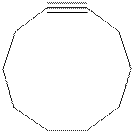
Concept explainers
(a)
Interpretation:
The model of cyclohexyne is to be built. An explanation for the instability of cyclohexyne structure is to be stated.
Concept introduction:
Answer to Problem 14.1P
The model of cyclohexyne is shown below.

Cyclohexyne is unstable because of the ring strain due to the reduced bond angle in six carbon cyclic structure.
Explanation of Solution
Alkynes are hydrocarbons containing at least one carbon-carbon triple bond. The triple bonded carbons are sp hybridized. Alkynes have a linear geometry with bond angle of

Figure 1
In cyclohexyne, the six carbon atoms ring contains one carbon-carbon triple bond. The bond angle from
Cycloalkynes with carbon ring less than
(b)
Interpretation:
The structure of cyclodecyne is to be built. The stability of cyclodecyne and cyclohexyne is to be compared.
Concept introduction:
Alkynes are hydrocarbons containing at least one carbon-carbon triple bond. The triple bonded carbons are sp hybridized. Alkynes due to triple bonds do not rotate and have linear geometry with bond angle
Answer to Problem 14.1P
The model of cyclodecyne is shown below.

Cyclodecyne is more stable than cyclohexyne due to less bond angle strain.
Explanation of Solution
Alkynes are hydrocarbons containing at least one carbon-carbon triple bond. The triple bonded carbons are sp hybridized. Alkynes have a linear geometry with bond angle of

Figure 2
Cyclodecyne is comparatively stable than cyclohexyne because of the reduced ring strain. In cyclodecyne, the ten membered carbon ring of is large enough to accommodate a triple bond due to its floppiness arised by carbon-carbon bond rotations.
In cyclohexyne, the six carbon atoms ring contains one carbon-carbon triple bond. The bond angle from
The structure of cyclodecyne is shown in Figure 2.
Cyclodecyne is more stable than cyclohexyne due to less bond angle strain and large ring size of cyclodecyne.
Want to see more full solutions like this?
Chapter 14 Solutions
Organic Chemistry, Ebook And Single-course Homework Access
- pls helparrow_forward35) Complete the following equation by drawing the line the structure of the products that are formed. Please note that in some cases more than one product is possible. You must draw all possible products to recive full marks! a. ethanol + 2-propanol + H2SO4 → b. OH conc. H2SO4 CH2 H3C CH + K2Cr2O7 C. d. H3C A pressure CH3 + H2 CH Pt catalystarrow_forward21) The rate of reaction depends upon: a. the concentration and nature of reactants b. the temperature of the reaction C. whether or not a catalyst was used d. all of the above 22) A Maxwell-Boltzmann curve shows the distribution of molecular energies in a reaction system. When the temperature in this system is increased, the peak is a. higher and further to the right. b. higher and further to the left. c. lower and further to the right. d. lower and further to the left. 23) Which of the following correctly describes the reaction represented by the reaction below? CaCO3 (s) + energy → CaO (s) + CO2 (g) a. It is exothermic and the potential energy is greater in the reactants than the products. b. c. It is exothermic and the potential energy is greater in the products than the reactants. It is endothermic and the potential energy is greater in the products than the reactants. d. It is endothermic and the potential energy is equal for the products and reactants.arrow_forward
- 30) Substance A to E below are listed with several of their properties. The identities of the substances are identified in random order below: Iron, ethane, ethanol, sodium nitrate, graphite First classify each substance as either a polar covalent compound, non-polar covalent compound, ionic compound, metallic solid, or network solid. Write your predictions in the sixth coloumn of the chart, under "type of substance." Then, identify the identity of the substance in the last coloumn. Substance Melting Point Boiling Point Solubility in H₂O Electrical Conductivity Type of Substance Identity of Substance (°C) (°C) as: Solid, Liquids, Solution A -182 -88 Insoluble No/No/- B 1538 2862 Insoluble Yes/Yes/- C 308 380 Soluble Yes/Yes/Yes Ꭰ 3456 Insoluble No/-/- E -114 78 Soluble No/No/Noarrow_forwardpls helparrow_forward28) Explain the process of galvanization. In your description, make sure to explain what metal is usually used for galvanization and why this metal used.arrow_forward
 ChemistryChemistryISBN:9781305957404Author:Steven S. Zumdahl, Susan A. Zumdahl, Donald J. DeCostePublisher:Cengage Learning
ChemistryChemistryISBN:9781305957404Author:Steven S. Zumdahl, Susan A. Zumdahl, Donald J. DeCostePublisher:Cengage Learning ChemistryChemistryISBN:9781259911156Author:Raymond Chang Dr., Jason Overby ProfessorPublisher:McGraw-Hill Education
ChemistryChemistryISBN:9781259911156Author:Raymond Chang Dr., Jason Overby ProfessorPublisher:McGraw-Hill Education Principles of Instrumental AnalysisChemistryISBN:9781305577213Author:Douglas A. Skoog, F. James Holler, Stanley R. CrouchPublisher:Cengage Learning
Principles of Instrumental AnalysisChemistryISBN:9781305577213Author:Douglas A. Skoog, F. James Holler, Stanley R. CrouchPublisher:Cengage Learning Organic ChemistryChemistryISBN:9780078021558Author:Janice Gorzynski Smith Dr.Publisher:McGraw-Hill Education
Organic ChemistryChemistryISBN:9780078021558Author:Janice Gorzynski Smith Dr.Publisher:McGraw-Hill Education Chemistry: Principles and ReactionsChemistryISBN:9781305079373Author:William L. Masterton, Cecile N. HurleyPublisher:Cengage Learning
Chemistry: Principles and ReactionsChemistryISBN:9781305079373Author:William L. Masterton, Cecile N. HurleyPublisher:Cengage Learning Elementary Principles of Chemical Processes, Bind...ChemistryISBN:9781118431221Author:Richard M. Felder, Ronald W. Rousseau, Lisa G. BullardPublisher:WILEY
Elementary Principles of Chemical Processes, Bind...ChemistryISBN:9781118431221Author:Richard M. Felder, Ronald W. Rousseau, Lisa G. BullardPublisher:WILEY





